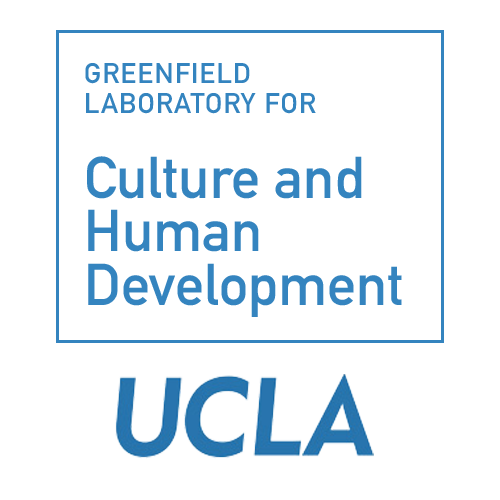Articles in Journals and other periodicals
- Evers, N. F. G., Greenfield, P. M., & Evers, G. W. (2021). COVID-19 shifts mortality salience, activities, and values in the United States: Big data analysis of online adaptation. Human Behavior and Emerging Technologies. DOI: 10.1002/hbe2.251
- Gillespie-Lynch, K., Greenfield, P. M., Lynn, H., & Savage-Rumbaugh, S. (2014). Gestural and symbolic development among apes and humans: Support for a multimodal theory of language evolution. Frontiers in Psychology, 5, Article 1228, 1-10. **Article viewed or downloaded 11,430 times online, as of October, 2015.
- Gillespie-Lynch, K., Greenfield, P.M., Feng, Y., Savage-Rumbaugh, S. and Lyn, H. (2013). A cross-species study of gesture and its role in symbolic development: Implications for the gesture theory of language evolution. Frontiers in Psychology. 4, 160.
- Gillespie-Lynch, K., Greenfield, P. M., Lyn, H., & Savage-Rumbaugh, S. (2011). The role of dialogue in the ontogeny and phylogeny of early symbol combinations: A cross-species comparison of bonobo, chimpanzee, and human learners. First Language. Published online June 20, 2011. DOI: 10.1177/0142723711406882.
- Lyn, H., Greenfield, P. M., & Savage-Rumbaugh, E. S. (2010). Semiotic combinations in Pan: A comparison of communication in a chimpanzee and two bonobos. First Language. DOI: 10.1177/0142723710391872
- Lyn, H., Greenfield, P. M., Savage- Rumbaugh, S., Gillespie-Lynch, K., & Hopkins, W. (2010). Nonhuman primates do declare! A comparison of declarative symbol and gesture use in two children, two bonobos, and a chimpanzee. Language and Communication.
- Lyn, H., Greenfield, P., & Savage-Rumbaugh, E.S. (2006). The development of representational play in chimpanzees and bonobos: Evolutionary implications, pretense, and the role of interspecies communication. Cognitive Development, 21, 199-213.
- Pyn-Johnson, J., Fragaszy, D. M., Hirsh, E. M., Brakke, K.E., & Greenfield, P. M. (1999). Strategies used to combine seriated cups by chimpanzees (Pan troglodytes), bonobos (Pan paniscus), and capuchins (Cebus apella). Journal of Comparative Psychology.
- Piñon, D., & Greenfield, P. M. (1994). Does everybody do it? Hierarchically organized sequential activity in robots, birds and monkeys. Behavioral and Brain Sciences, 17(2), 361-365.
- Greenfield, P. M., & Savage-Rumbaugh, E. S. (1993). Comparing communicative competence in a child and chimp: The pragmatics of repetition. Journal of Child Language, 20, 1-26.
- Greenfield, P. M., & Savage-Rumbaugh, S. (1992). Comparing the ontogeny of symbol use in Pan paniscus and Homo sapiens. Bulletin of the Chicago Academy of Sciences, 15(1), 26. (Abstract).
- Greenfield, P. M. (1991). Behavioral and Brain Sciences 14, 531-595. Language, tools and brain: The ontogeny and phylogeny of hierarchically organized sequential behavior.
- Greenfield, P. M. (1989). Commentary on “Spontaneous tool use and sensorimotor intelligence in Cebus compared with other monkeys and apes” by S. Chevalier- Skolnikoff. Behavioral and Brain Sciences, 12 (3), 599-600.
- Greenfield, P. M. & Savage-Rumbaugh, E. S. (1983). Perceived variability and symbol use: A common language-cognition interface in children and chimpanzees. Journal of Comparative Psychology, 98, 201-218.
- Greenfield, P. M. (1978). Commentary on “Developmental processes in language learning of child and chimp” by Savage-Rumbaugh and Rumbaugh. In Cognition and Consciousness in Nonhuman Species. Open Peer Commentary and Authors’ Responses. The Behavioral and Brain Sciences, 4, 555-629.
Books and edited volumes
- Greenfield, P.M. & Lyn, H. (2006). Symbol combination in Pan: Language, action, culture. In D. Washburn (Ed.), Primate Perspectives on Behavior and Cognition (pp. 255-267). Washington, DC: American Psychological Association.
- Greenfield, P.M., Maynard, A.E., Boehm, C., & Yut Schmidting, E. (2000). Cultural apprenticeship and cultural change: Tool learning and imitation in chimpanzees and humans. In S.T. Parker, J. Langer, & M.L. McKinney (Eds.), Biology, brains, and behavior: The evolution of human development (pp. 237-277). Santa Fe: SAR Press.
- Greenfield, P.M. & Savage-Rumbaugh, E.S. (1991). Imitation, grammatical development, and the invention of protogrammer. In N. Krasnegor, D. Rumbaugh, M. Studdert- Kennedy, & R. Schiefelbusch (Eds.), Biological and behaviorial determinants of language development (pp. 235-258). Hillsdale, NJ: Erlbaum. (Earlier draft distributed as a Bunting Institute Working Paper.)
- Greenfield, P.M. & Savage-Rumbaugh, E.S. (1990). Grammatical combination in Pan paniscus: Processes of learning and invention in the evolution and development of language. In S. Parker & K. Gibson (Eds.), “Language” and intelligence in monkeys and apes: Comparative developmental perspectives (pp. 540-578). Cambridge, England: Cambridge University Press.
- Savage-Rumbaugh, S., Sevcik, R.A., Brakke, K.E., Rumbaugh, D.M., & Greenfield, P.M. (1990). Symbols: Their communicative use, comprehension, and combination by bonobos (Pan paniscus). In L.P. Lipsitt & C. Rovee-Collier (Eds.), Advances in infancy research, 6, 221-278. Norwood, NJ: Ablex.

